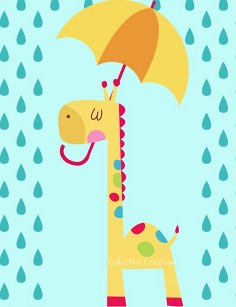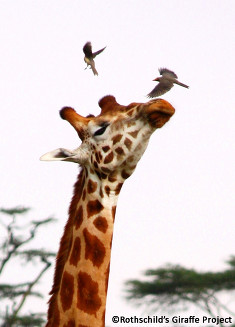

Rothschild's

Giraffe
Project
CONSERVATION & RESEARCH IN AFRICA
CONSERVATION
Our research is being used to develop long-term conservation strategies for Rothschild's giraffe (and in some cases, all giraffe) in Kenya.
We work closely with the Kenya Wildlife Service (KWS) and have been asked to help develop the National Giraffe Conservation Strategy for Kenya; the first giraffe-specific conservation plan ever seen on the African continent.
We also work closely with wildlife managers and conservation organisations in Kenya to design and facilitate giraffe conservation projects throughout the country.

Effective conservation of giraffe incolves the preservation of large tracts of habitat. This habitat is also often home to hundreds of other mammal, bird and insect species, and so by conserving giraffe we inadventently also protect other species as well. This makes the giraffe an excellent umbrella species.
With fewer than 670 individuals remaining in the wild, the Rothschild's giraffe is listed as Endangered on the IUCN Red List and is under real threat of extinction in the wild.
Giraffe are often not considered a conservation priority and are frequently overlooked in conservation or management plans. This chart demonstrates just how small the population of Rothschild's giraffe is in comparison to some other species that receive a lot of conservation attention.
Shocking, isn't it?
SOMEONE HAD TO DO SOMETHING.
SO WE DID.
Data taken from IUCN Red List 2012. Graph not to scale. A survey was carried out by asking 200 people to give the names of a few Endangered species. The above graph represents the eleven most popular answers. Note that some animals are listed at the species level, some at the subspecies level. This is based on answers given and represents the opinions of the survey participants; for example, participants mentioned "Tigers" or "Elephants" rather than specifying subspecies. The graph is to demonstrate general opinion on which animals are identified as "Endangered" by the general public and to list these species' population figures in comparison with that of the Rothschild's giraffe (who was mentioned only once).

In 2011, wildlife toruism contributed 750 million USD to Kenya's economy and provided 14% of the country's employment. The loss of wildlife in Kenya would have catastophic effects. By conserving giraffe, we protect habitat, hundreds of other species and safeguard the future of the wildlife toruism industry. Ultimately we are protecting the future for millions of Kenyan citizens and aiding development.
By conserving giraffe, not only do we protect one of Africa’s most iconic species, we also protect exceptional levels of biodiversity. By contributing such a great deal to wildlife conservation, we assist the country's economy by ensuring the preservation of the wildlife tourism industry.